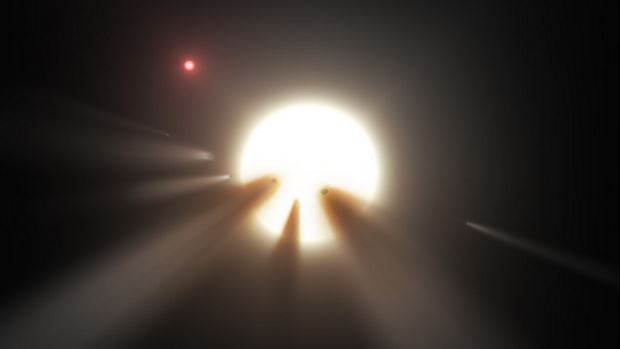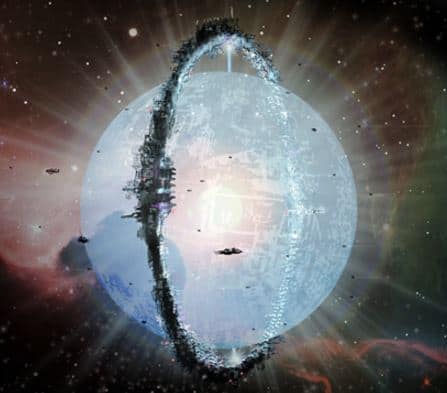For all those who thought an alien megastructure could explain the bizarre dimming of star KIC 8462852, a team of scientists has concluded that it is probably something completely different and much less exciting. The dimming of the star’s light curve was likely caused by the destruction of a family of comets, say researchers from Iowa State University.
Alien enthusiasts should not lose all hope. The scientists stressed the destruction of a family of comets is their most likely explanation, but they have not discarded the alien megastructure theory (because they did not look into that possibility).
Initially, there were several explanations for the 22% dimming of KIC 8462852. Some suggested it was caused by a catastrophic collision of the star’s asteroid belt, others wondered whether a giant impact had disrupted a nearby planet, a family of comets breaking apart, or perhaps a dusty cloud of debris and rock.
 An artist’s illustration of a star behind a shattered comet. Scientists believe KIC 8462852’s unusual light signals are probably caused by dusty comet fragments, which blocked the star’s light as they passed in front of it. (Image: Iowa State University)
An artist’s illustration of a star behind a shattered comet. Scientists believe KIC 8462852’s unusual light signals are probably caused by dusty comet fragments, which blocked the star’s light as they passed in front of it. (Image: Iowa State University)
Astro-engineering project theory got everybody excited
Alien enthusiasts became super excited when scientists across the world said they could not discount the possibility that the dimming was caused by a an astro-engineering project created by super-advanced intelligent extraterrestrials. An astro-engineering project refers to a structure at least the size of a planet.
Some people, including many scientists, wondered whether a Dyson Swarm surrounding the star could cause it to dim so much and in such a bizarre way. A Dyson Swarm, also known as a Dyson Sphere, is a hypothetical megastructure that completely encompasses a star and captures much of its power output.
The term – Dyson Swarm – was named after English-born American mathematician and theoretical physicist Freeman John Dyson (born 1923). He once said “One should expect that, within a few thousand years of its entering the stage of industrial development, any intelligent species should be found occupying an artificial biosphere which completely surrounds its parent star.”
 An artist’s impression of a Dyson Swarm – an alien megastructure that completely surrounds a star and harnesses its power.
An artist’s impression of a Dyson Swarm – an alien megastructure that completely surrounds a star and harnesses its power.
Associate professor of physics and astronomy at Iowa State University, Massimo Marengo, became intrigued when he heard about the mysterious star found by citizen scientists on the Planet Hunters website.
Those citizen scientists had been highlighting measurements of the brightness of the star recorded by NASA’s Kepler spacecraft. Very slight dimming of a star’s brightness can suggest that a planet is passing in front of it. That is how Kepler scientists – as well as citizen scientists using the Internet to help analyze the light curves of stars – are seeking out exoplanets.
But KIC 8462852 was intriguing. Its brightness dipped by up to 22%, and also changed irregularly, sometimes even for months at a time.
Scientists searched within Kepler’s database of 150,000+ stars and found nothing like this.
So Prof. Marengo, along with Alan Hulsebus, an Iowa State doctoral student, and Sarah Willis, from the Massachusetts Institute of Technology’s Lincoln Laboratory who used to be an Iowa State graduate student, decided to take a closer look at KIC 8462852 using data taken with the Infrared Array Camera of NASA’s Spitzer Space Telescope.
The wrote about their findings in The Astrophysical Journal Letters.
Probably just comet remains
The three authors wrote:
“The scenario in which the dimming in the KIC 8462852 light curve were caused by the destruction of a family of comets remains the preferred explanation.”
When Prof. Marengo and colleagues studied the star with Spitzer infrared data from January this year – two years after the Kepler readings – they did not see much. Any catastrophe near the star would have shown up as extra infrared emissions.
The researchers looked at two different infrared wavelengths: the shorter being consistent with a typical star, while the longer showed some infrared emissions, however, not enough to reach detection threshold.
The authors concluded there were no excess infrared emissions, i.e. no sign of an asteroid belt collision, a dusty cloud of debris and rock, or a massive impact on a planet.
Therefore, the most likely explanation for the unusual dimming of KIC 8462852 was the destruction of a family of comets close to the star.
The fragments of the comets, coming in at speed at a steep, elliptical orbit could create a large debris cloud capable of dimming the star. Then the cloud would move away, the star’s brightness would be restored, leaving no trace of excess infrared light.
And the likelihood of an alien megastructure?
Prof. Marengo said:
“We didn’t look for that. We can’t really say it is, or is not. But what the star is doing is very strange. It’s interesting when you have phenomena like that – typically it means there’s some new physical explanation or a new concept to be discovered.”
Citation: “KIC 8462852: THE INFRARED FLUX,” Massimo Marengo, Alan Hulsebus, and Sarah Willis. the Astrophysical Journal Letters, Volume 814, Number 1. 19 November, 2015.
